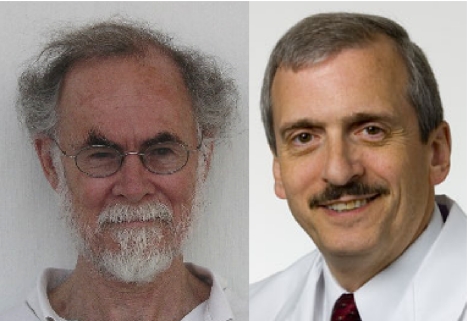Abstract
In 1978, Jonathan Sprent and Robert Korngold proved that graft-versus-host disease (GVHD) is caused by donor T cells that attack the host's non-MHC antigens. T cell depletion of donor grafts has since become a staple of transplantation strategies to combat leukemia and other inherited blood disorders.
GVHD occurs in about half the patients who receive bone marrow transplants (BMT) from HLA-matched donors and results in multiple organ failure and death (1). Early anti-GVHD strategies using immunosuppressive drugs were unsuccessful and they inhibited immune cells from both graft and host. A graft-specific strategy was hard to develop as the cellular events that led to GVHD were still unclear.
Figure 1.
Jonathan Sprent (left) and Robert Korngold
Minor antigens, major disease
In mid-1970, Sprent, then a postdoctoral fellow at the Basel Institute of Immunology, was studying tolerance to histocompatibility antigens in bone marrow chimeras. He, along with Harald von Boehmer, found that preventing GVHD in mice was relatively easy. Bone marrow harvested from MHC-incompatible parents and depleted of T cells did not cause GVHD when transferred into irradiated mice (2). They attributed this finding to the absence of mature donor T cells and the induction of tolerance when the donor stem cells matured into new T cells in the host thymus.
The clinicians who were struggling to contain GVHD in human patients were, however, unimpressed. At a transplantation conference in 1976, the skeptics vehemently pointed out that GVHD in fact occurred between HLA-matched donors who only differed in their expression of non-HLA antigens—called “minor histocompatibility antigens” (mHA). “They dismissed our mouse model as being irrelevant,” recalls Sprent. He was challenged to produce a transplant model where GVHD occurred in MHC-matched mice across a mHA barrier and then find a way of overcoming the disease.
A new model
Sprent, who was by now a faculty member at the University of Pennsylvania (Philadelphia), and Robert Korngold, a newly arrived Ph.D. student, began transplanting bone marrow cells between various pairs of mice matched for MHC but not for mHA. Perhaps due to the extremely low numbers of mature T cells in mouse (but not human) bone marrow, only 2 of the 11 strain combinations studied got lethal GVHD. Nevertheless, disease developed in the other pairs when spleen and lymph node cells were mixed in with the bone marrow cells, suggesting a role for mature T cells in GVHD. This theory was confirmed when T cell–depleted bone marrow failed to induce GVHD in the lethal combinations. The team also showed that it only took 3 × 104 T cells in the graft to mount a lethal response against the host. They published these results in 1978 in a landmark paper in the Journal of Experimental Medicine (3).
In the next few years, Korngold and Sprent used this model to define other features of T cell–mediated GVHD. They found that the mHA were being presented to donor T cells by the class I MHC of the recipient (4), and that both CD4 and CD8 T cells caused lethal disease but their relative contributions were strain dependent (5). In the meantime, T cell depletion of donor grafts was being tried out in cancer clinics around the world.
Improving treatment
These human studies confirmed that T cell depletion lowered the risk of GVHD, but other problems were cropping up. Graft rejection went from being a rare to a common problem. “We were finding out that the no-free-lunch theory was true in medicine as well,” says Robertson Parkman, who directs transplantation research at the Children's Hospital of Los Angeles.
Depleted grafts also had no mature T cells to attack the host's leukemic cell population. For reasons that are not yet clear, this graft versus leukemia activity was not fully effective even once the grafted cells had fully differentiated. Graft recipients were further compromised by pretransplant irradiation and posttransplant immunosuppressive drugs that allowed latent viral infections to become reactivated.
Parkman and others now allow time for the depleted graft to establish itself before adding back donor T cell populations that have been filtered for GVHD-causing T cells and enhanced for antileukemic activity. These methods have not yet produced a foolproof cure, but better transplantation combined with new drugs have increased the five-year survival rate to 80% in patients with chronic leukemia (6), a great improvement over the 35% that was common before the experiments of Korngold and Sprent.
References
- 1.Ho, V.T., and R.J. Soiffer. 2001. Blood. 98:3192–3204. [DOI] [PubMed] [Google Scholar]
- 2.von Boehmer, H., et al. 1975. J. Exp. Med. 141:322–334. [DOI] [PMC free article] [PubMed] [Google Scholar]
- 3.Korngold, R., and J. Sprent. 1978. J. Exp. Med. 148:1687–1698. [DOI] [PMC free article] [PubMed] [Google Scholar]
- 4.Korngold, R., and J. Sprent. 1980. J. Exp. Med. 151:1114–1124. [DOI] [PMC free article] [PubMed] [Google Scholar]
- 5.Korngold, R., and J. Sprent. 1987. J. Exp. Med. 165:1552–1564. [DOI] [PMC free article] [PubMed] [Google Scholar]
- 6.Drobyski, W.R., et al. 1999. Blood. 94:434–441. [PubMed] [Google Scholar]



